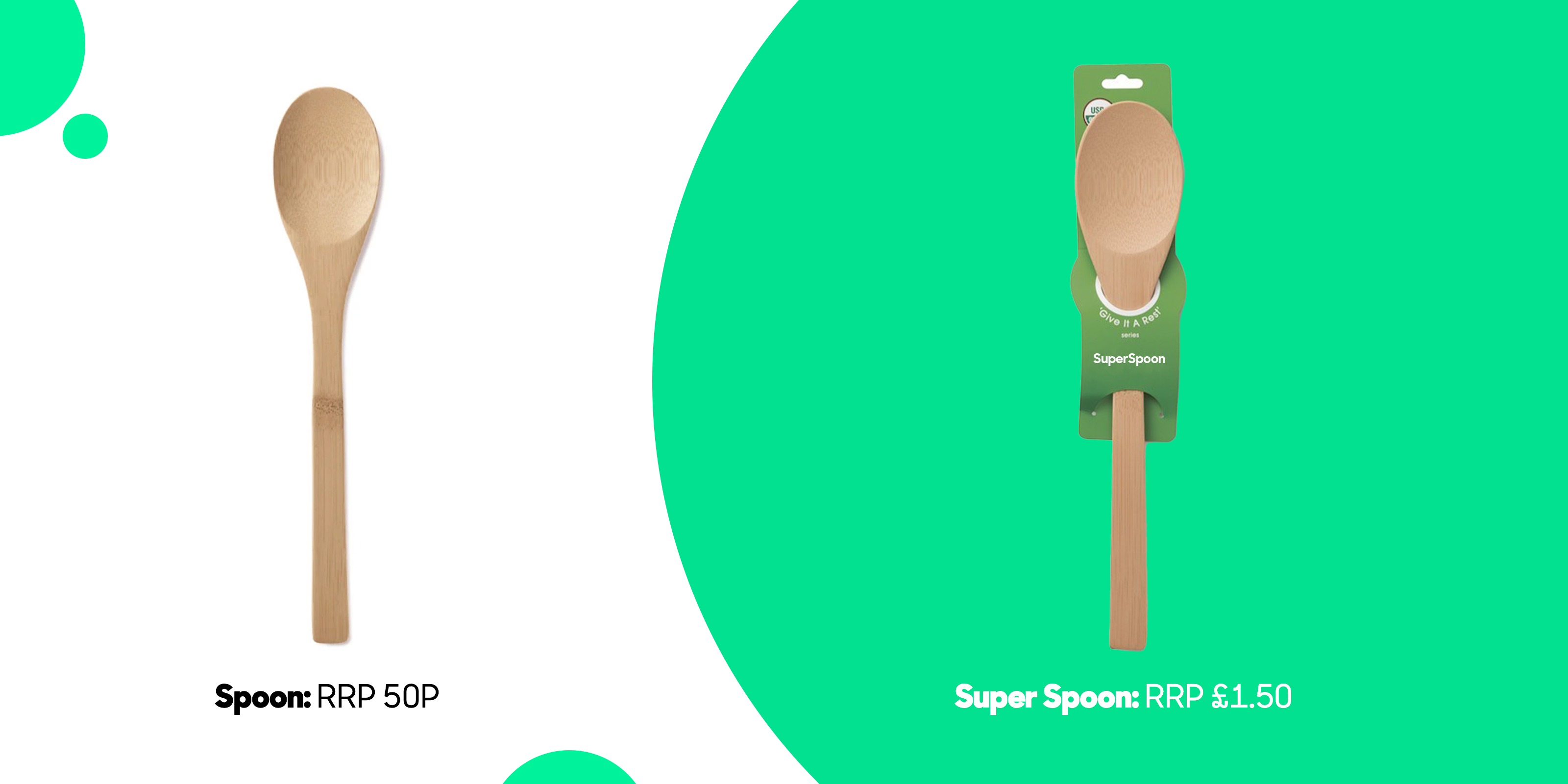Posted on November 3, 2021
Updated on March 13, 2023
6 min read time

The answer was simple: brands exist to extract a premium return on an investment.
If you make a spoon, it will have a utility value. Let’s say it’s 50 pence. With it, you can stir your coffee and eat your yoghurt. And the spoon-maker can decide that’s all good, since they procure their raw materials, manufacture their goods, distribute them, and collect cash, whilst still deriving a profit from that 50p of retailed value. Let’s say it’s a healthy profit margin of 20% - so they are making 10p per spoon. They sell 10 million spoons a year, with a turnover of £5m and a net profit of £1m.
But if you create the SuperSpoon company, you’re making a brand. Now you have to add on the costs of building a brand, which are likely to include: an identity, packaging, communications, PR, more extensive customer service and more human resource. Let’s say this will cost you 50p per spoon. You now have your original utility-product costs of 40p, and new brand-related costs of 50p – that’s 90p in all.
You’re investing more capital and there’s more at risk.
What’s the gain? If you can sell your SuperSpoons at £1.50, you now have a profit of 60p per spoon, or 40%. You’ve risked more, employed more capital, created a more complex organisation; yet you’re rewarded with more cash per spoon, and a premium return on your investment.
Your 10 million SuperSpoons generate £15m and your profit is £6m. You took a bet and increased your winnings 6-fold.

They are here to create greater wealth for their enterprises. And they need to be managed to create the greatest return possible from the investment used to make them.
So, what is brand management?
Without wishing to sound like I’m in awe of it, it’s a stupefyingly complex task. And this is why…
There are at least 14 Marketing Levers.
For each and every one of them, there are up to 6 actions that could be taken…so you might be thinking that there are basically 14 x 6, or 84, decisions a Brand Manager might take.
It’s not quite that linear, though. Marketing Levers work in tandem. Produce a new pack and you’ll want new communications, then broader distribution, and perhaps a price adjustment. We have calculated that there are 54 possible Lever actions, and assuming a Brand Manager pulls just 6 of them in a given year, the interaction between all of the potential actions, in any given order, actually results in a combination of over 25 million (yes, no typo – million) choices a Brand Manager can make during the typical course of a year in marketing.
So there you are. Charged with creating a premium return on investment, risking greater capital and involving more complexity in a business, and you have to find a way to navigate 25 million choices, to produce success. It’s obviously no easy task.
It would be untrue to say that brands are new concepts and that Brand Management is a new art. Roman Emperors knew what they preferred and apparently Julius Caesar’s favourite wines were Greek, but his Roman choice was called Mamertine. Whoever made it surely profited.
The M2 heavy machine gun is probably the most known of the U.S Army's weapons, designed by the famous John Browning towards the end of World War I and entered into service in 1933. In its own world of soldiers, it has unparalleled, positive currency.
Ask most young (not-yet-driving) children to name their favourite car and you’re likely to hear either Tesla or Porsche. Our culture is infused with these compass points in life. We curate a whole internal eco-system of brands. Some we hold close and they have a barnacle-like grasp of us; others are peripheral, traded in and out with little compunction.
Not only are you, as a Brand Manager, charged with navigating 25 million choices, but you also have an audience that is sophisticated, busy and whose attention is difficult to attract and retain. Yet you have to inveigle your way into that small, curated space where an individual keeps their preferred brands and, when the opportunity arises, make sure your brand seduces and persuades its way into that person’s life. What a job!
Over the last 8 years or so, Artificial Intelligence has had a stuttering start in life. Machine Learning (ML) has changed our lives. AI has become really good at predicting stuff. And with more data, the machines improve themselves.
Wherever there is a great complexity of choice, AI stands a good job of learning to evaluate and decide best choices. At its best, it does so with far fewer failures, at much lower cost, with greater speed, and ultimately with more reliability, than those of us wandering around ruminating over what might be the best decision in a given situation with a huge number of variables to consider. With vast experience, we might have the nous and the nose for the right direction, but have limited ability to parse massive amounts of data to formulate the right decision.
AI Brand Management becomes a really tantalising thing – a reliable ally in the identification of which marketing investments will result in the greatest returns. It’s like having a friendly terminator come to sit by your side, ready to advise on the likelihood of success with any given action.

Until now, Brand Management has been an art, something that is taught and passed on through experience and time. It’s been a process of iterative learning – succeed, fail, revise, try again, succeed, fail, revise, go again, and so on.
Like in many other arts, there are gifted people. They’ve created campaigns we’ll never forget (thanks, John Hegarty for Levi’s and others), made products we’d never live without now (thanks, Steve Jobs, first for the Mac), and devised strategies for distribution we never conceived of before (seriously Jeff Bezos, that was quite a dream in the garage). There are other, less known people who, year after year, create growing sales, cover over production difficulties, deal with political intrusions that harm their distribution deals, and win in a host of other day-to-day skirmishes without which no brand would endure.
For every Richard Branson, there are thousands of us out there crimping and preening our brands each and every un-celebrated day, to keep it steadily raising its value. It’s messy.
Glorious, hilarious, heart-breaking, colourful, tense, euphoric, upsetting, chaotic. Art. All together, an uncertain messiness.
With AI, we can turn it into a predictive science, that improves each day. A game of odds you are much more likely to win. We make your efforts far more likely to be the most rewarding. And to turn your brand into the best it can be. As a result, to grow bigger, faster.
At its most basic, we spot patterns - between things you do and the results you produce. We learn that if you do x and y, z results. We find relationships between data points – for example, where distribution has been increased, price decreased, advertising held steady, messaging changed, and new packaging introduced…we can find the key variable that you might not want to invest in again. Or the killer piece of content which changed linear growth into super-linear. With real confidence, we can show you that if you take action A, then B will result.
Training your AI machine is the key to making it great. ProQuo is stuffed full of great marketeers, from many different walks of life, who’ve managed all sorts of different brands. We deploy their experience – the art they’ve always used – and we interlace it with what we learn other great marketeers do.
We teach the machines what these brand-artists would make as decisions. We then feed in the results of these activities – these investments in brand management. It sees the good, the bad and the ugly. And then we help it ingest even more – the commercial data of all the brands on our Brand Management Platform, from media investment, to stock levels, promotional activities to external events that might have impacted brand consumption, like a fuel strike, or pandemic.
The more data the AI has, the smarter the pattern-finding becomes. It distils. It learns things by category, by demographic, by time, by audience. It’s a quid pro quo – and precisely why we’re called ProQuo. The AI’s super-brain extends beyond any experience any one of us can put together, and achieves a wisdom that transcends what any one of us can learn in a linear career, even those of us who have happily twisted and turned along the way.
There will always be a special place for the masterstroke of genius, for the lateral thought that utterly subverts a category and delights its consumers. Well done, Innocent. Well done, Uber.
All the same, most of the time, good Brand Management is about getting the odds right, getting as many things right as you can, knowing that decisions you’re making are ones based on more than a hunch or a hope. It’s about being sure of what you’re doing.
AI Brand Management is here. It’s designed to help every Brand Manager be their best, and for their business asset – their brand – to return a premium on the investments made by the business.
You could say, it hands you a SuperSpoon.
Our intelligent platform will take your brand further, faster.
Don’t believe us?
© 2020-2023 ProQuo AI International
All rights reservedWebsite by Blend